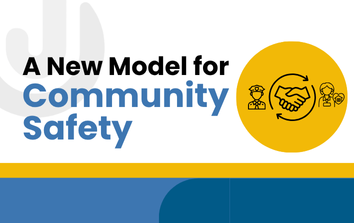Effective community partnerships are vital to a successful Crisis Intervention program. Law enforcement, mental health providers, and advocates can only improve a community’s response to mental health crises through community involvement and collaboration. Therefore the importance of community partnerships for crisis intervention teams should be considered.
Community partnerships are relationships between organizations that work in good faith toward a common goal. Successful partnerships can provide a more comprehensive approach to mental health response and enhance the power of advocacy and resource development in the community.
Based on community needs, additional partners might include housing and other service providers, criminal justice personnel such as prosecutors and jail administrators, and elected officials.
Community partnerships for crisis intervention teams genuinely form the foundation of a successful program. However, understanding that effective collaboration requires much more than a decision to work together is vital. True community partnerships take time to build because they rely on trust, understanding, and respect and require to give and take from all partners.
To assist teams in establishing effective community partnerships, the U.S. Department of Justice, Office of Community-Oriented Policing Services (COPS) has developed a toolkit to help CIT teams initiate partnerships within the community. The toolkit provides guidance to law enforcement for developing, improving, and sustaining successful community partnerships. The elements discussed include the following points which will be discussed in this article:
- Discovering and building on the strengths of each partner
- Leveraging technology
- Tools to plan and chart progress
Discovering and Building on the Strengths of Each Community Partner
From the beginning of the partnerships, it is essential to recognize the unique skills and strengths each agency brings to the table and appreciate the added value that exists when those strengths are combined. This united collaboration can accomplish what individuals alone cannot. It can prevent duplication of efforts, enhance the power of resources, create greater public awareness, and provide a more comprehensive approach to addressing the community’s needs.
The process of building and sustaining community partnerships for crisis intervention teams is ongoing. It begins with a shared vision and ends with a comprehensive action plan. Trust is the core of the relationship. It is the hub with the plan acting as the spokes of a wheel.
Discovering the strengths of potential partners can be accomplished through a frank assessment of each organization’s resources, skills, and commitment to the crisis intervention team program. Therefore, the March of Dimes developed a toolkit entitled: Making Community Partnerships Work.” While the toolkit was not specifically designed for crisis intervention programs, a list of questions is included that can help any organization understand its strengths and appropriateness for the program.
These include: 1) are you committed to the program? 2) do your mission and priorities encourage, support, and recognize the value of this partnership? 3) what resources can you commit to the partnership? 4) what are the potential benefits of this partnership for your organization and 5) what are the benefits of your partnership to the community? Using these questions as a guide can help discover partner strengths that can later be built upon to improve the team.
Developing Teamwork Strategies
Everyone knows the saying: “Two heads are better than one.” When it comes to community partnerships, this phrase is especially true. Realistically, however, collaboration is not always easy to achieve. Although the components of a successful partnership may seem basic, implementing those components can be challenging. That’s why developing teamwork strategies is so important. The good news is that many proven methods are available that can help bring about excellent results:
Ensure that all partners have a part in developing your team’s shared vision and common goals. A jointly developed shared vision that incorporates all partners’ expectations is a good foundation for building a successful team. It brings focus to the team. Their success depends mainly on the clarity of the shared vision and whether it has incorporated all partners’ ideas and concerns. Teams should set measurable, realistic goals that are outcome-oriented and consider the needs of all agencies.
Define each partner’s roles and responsibilities. Defining and articulating the roles and responsibilities of each agency provides clear expectations and allows members of the partnership to make informed decisions. Clearly defined roles and responsibilities increase the likelihood of successfully implementing the action plan. Remain open to redistributing roles if it benefits the shared vision.
Promote frequent communication. A successful partnership can only function with open communication. Regular contact enhances teamwork and builds trust. Establish and adhere to regularly scheduled meetings but also implement ongoing informal communication. Let partners know their opinions are valued, positive or negative. Define acronyms and technical terms so that all members speak the same language. Openly share the successes of all partners.
Leveraging Technology
Technology is critical during times of crisis. Crisis intervention teams and their partners must have secure channels of communication. Data must be accessible quickly, and sensitive documents must remain protected. Yet, even in our modern, fast-moving digital age, many organizations still struggle with an “analog” approach to crisis management, relying on hard-copy documents and phone calls. Leveraging advanced technology during a crisis today is not a luxury. It is a necessity.
The Substance Abuse and Mental Health Services Administration (SAMHSA) has created a step-by-step guide to assist crisis intervention teams and their partners in creating a system to ensure effective data collection and sharing. The guide contains seven steps for identifying needed data and strategies to capture it. The steps are based on the input, lessons learned, and successes of CIT programs across the country.
While there are an overwhelming number of options when it comes to technology, the key to success is choosing the right tech tools for your team. That’s why so many law enforcement teams choose Julota.
Julota’s cloud-based solution means that all your community partners’ applications are available anytime, anywhere, at the touch of a button. Migrating your information to the cloud fosters better collaboration and provides quick, secure access to shared data via smartphones, tablets, or computers. For example, law enforcement can communicate with mental health professionals or other partners while at the scene, allowing for a quicker resolution to the situation.
Ensure Long-Term Sustainability
The SAMHSA guide identifies three key data points that should be considered critical to CIT programs. They include Mission Critical Data, Intermediate Data, and Advanced Data. For this article, we will concentrate on the third data point: Advanced Data, as it relates to the long-term sustainability of a program.
Advanced data is considered the most sophisticated data as it allows for a more comprehensive look at the function, progress, and success of the entire community partnership. Gathering these data points requires the agreement and involvement of all mental health agencies that work with CIT officers. These partners must communicate and work cohesively to ensure data gathering that leads to a comprehensive understanding of the local impact of the crisis intervention team.
Julota’s powerful platform can provide the dynamic data collection and analysis that is indicated for advanced data. Its visualization tools take raw data and extract patterns that show actionable insights into the program’s progress. These insights can include things like response time from the emergency mental health call to officer/team arrival and time spent on scene.
They can also indicate time spent transporting individuals to drop off or jail and total time on calls from dispatch to call conclusion. Programs should also consider collecting data on service usage patterns to determine whether any disparity exists among populations served or areas covered. Successful community partnerships must have sufficient means to sustain their program. The collection of advanced data contributes to determining where funds and resources are most needed.
CONCLUSION
Law enforcement and community leaders everywhere recognize the importance of community partnerships for crisis intervention teams for a better mental health response. Community partnerships are integral to any long-term solution, but building a successful team is a marathon, not a sprint.
They take time, trust, and respect to build. They provide an important opportunity for the community to come together to ensure better mental health outcomes.
As these partnerships work together in good faith toward a shared vision and common goal, they can produce positive change and honestly address the underlying issues involving mental health. It has been said that the impact of a crisis is rarely determined by the crisis itself but rather by the quality of the response.
This is particularly true in the case of community partnerships. The effort must be coordinated and heartfelt, with all members contributing. The program will be much more likely to endure with the active participation of multiple organizations than a program sustained by a single organization.
Effective partnerships exist when each partner feels ownership and is vested in the program’s success. As Abraham Lincoln once said: “If the strongest horse in the team would go ahead, he cannot, if all the rest hold back.”

